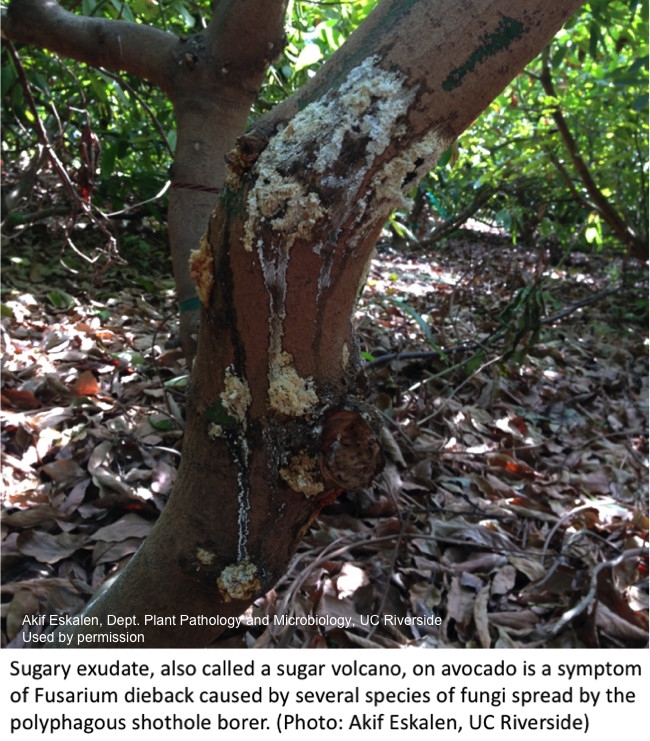Californians can help in the fight against invasive species by learning and participating during California Invasive Species Action Week, June 2–10.
During the week, the UC Statewide Integrated Pest Management Program invites the public to spend lunch learning about invasive tree killing pests, aquatic nasties like quagga mussels and nutria, and how the invasive weed/wildfire cycle is altering our ecosystems. http://ucanr.edu/sites/invasivelunch/
The invasive species killing trees is causing sugar volcanoes to erupt on avocado trunks and branches that might be infected with Fusarium dieback. Fusarium dieback is a invasive, beetle-vectored disease that causes damage on avocado and more than 39 other tree species. The disease has spread in urban forests and wild lands in the Los Angeles basin since early 2012, and in Orange and San Diego counties since early 2013 and Ventura County in 2015.
The symptoms — staining, sugary exudate, gumming and beetle frass — are often noticed before the tiny beetles (1.5–2.5 mm) are found.
As its name suggests, these beetles bore into trees. Near or beneath the symptoms, you might notice the beetle's entry and exit holes into the tree. The female tunnels into trees forming galleries, where she lays her eggs. Once grown, the sibling beetles mate with each other so that females leaving the tree to start their own galleries are already pregnant. Males do not fly and stay in the host tree.
Shothole borers have a special structure in their mouth where they carry two or three kinds of their own novel symbiotic fungi. Shothole borers grow these fungi in their tree galleries. It's these fungi that cause Fusarium dieback disease, which interrupts the transportation of water and nutrients in the host tree. Advanced fungal infections will eventually lead to branch dieback.
Early detection of infestations and removal of the infested branches will help reduce beetle numbers and therefore, also reduce the spread of the fungus.
- Chip infested wood onsite to one inch in size or smaller. If the branch is too large to chip, solarize them under a clear tarp for several months
- Avoid movement of infested firewood and chipping material out of infested area
Avocado is one tree host. Shothole borers successfully lay eggs and grow fungi in many tree hosts, with some of these trees susceptible to the Fusarium dieback disease. For more information about tree host species, where the shothole borer is in California, and what symptoms look like in other tree hosts, visit the UC Riverside Eskalen Lab website or the Invasive Shot Hole Borers website.
Content in this post taken from the UC IPM Avocado Pest Management Guidelines. Faber BA, Willen CA, Eskalen A, Morse JG, Hanson B, Hoddle MS. Revised continuously. UC IPM Pest Management Guidelines Avocado. UC ANR Publication 3436. Oakland, CA.
